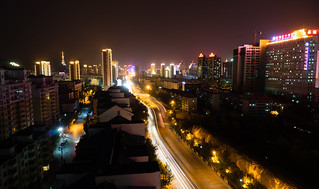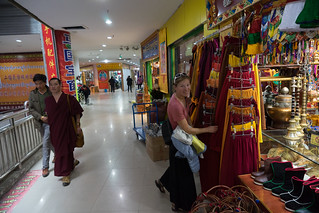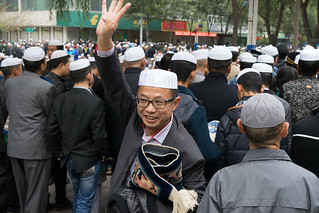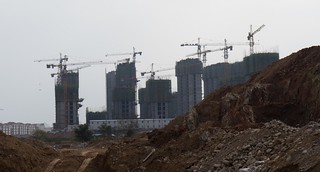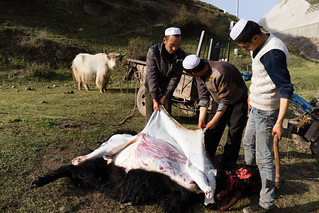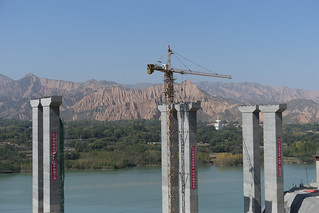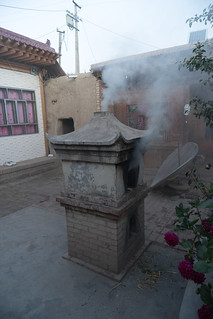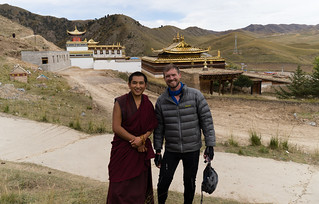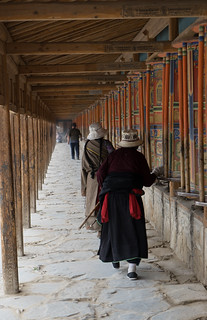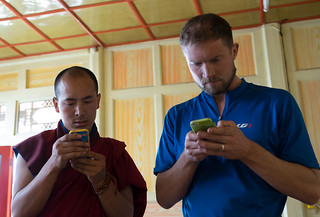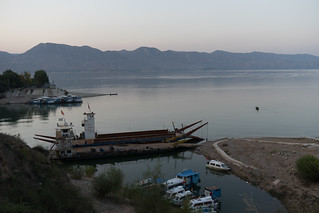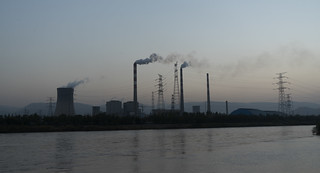Xining is described in the Lonely Planet as a “delightful provincial capital” and I envisioned old wooden buildings with graceful eaves lining tranquil streets. I was wrong. While not a huge city, Xining was the largest, busiest place we’d been since crossing the Caspian. The main street is at least four lanes wide, and crossing it was a challenge – the traffic lights turn green for all traffic on one axis all at once, including left and right turns. So when the light changes, all of the cars move at once – those turning left veer across the paths of cars, bikes, and pedestrians going straight, racing to complete their turn before the others get through the intersection. We got used to the system but it still baffles me that this sort of driving is not due to the lack of signals, but is in fact sanctioned by them.
In Xining, we visited with a friend of David’s from college who has been living in the region for years. She is studying Tibetan medicine and is fluent in the Tibetan language of Amdo (this is the friend we called for translation help earlier in the week). We bombarded her with questions about life in this part of China and enjoyed a visit to a temple and the Buddhist market. Again, my vision of what this would be like was way off – the guidebook mentions rows of stalls selling fabric and clothing, but months before our visit the old Tibetan market was razed, and vendors were moved to what can only be called a mall. So we visited a 4-story shopping mall, motionless prayer flags hanging limply above the escalators, and browsed through shop after shop selling everything from monks’ robes to yak butter (for offering candles) to Buddha statues. An assortment of people were in the market – mostly monks and Tibetans buying clothing, art, and incense, and a few tourists like us. It was definitely different from what I’d imagined, and while there was a bit of soullessness to the location, the buyers and sellers lent an air of authenticity. We also enjoyed some western comforts in Xining – good coffee and baked goods – before gearing up for the next leg of our trip.
We got a late start out of Xining because we decided to swing by the Great Mosque and see everybody assembling for the Eid al-Adha holiday, which honors Abraham’s willingness to sacrifice his son Isaac. What stood out to me, as people streamed to the mosque and set up their prayer mats on the sidewalk and street outside the mosque, was (a) they were all men; and (b) the police had blocked off the street to traffic. At first this looked like a nice service, keeping cars out so Xining’s Muslim citizens could celebrate the holiday even when the mosque was overflowing. Then we realized that there were rows of armored vehicles parked up the street, and some of the police had automatic weapons; they were clearly prepared for more than just crowd control, and it felt a bit heavy-handed. The street was too crowded to bike through, so we took turns ditching our bikes and wandering through the crowd to the front of the mosque. I thought I was used to being the only woman – as I often was at meals and events in the many Muslim countries we’d biked across – but I felt really out of place here.
We got back on our bikes and rode out of town, biking through entire brand new cities under construction. There were roads that didn’t exist on our map, lined with pictures of what was to come – large industrial parks, residential neighborhoods, everything, all being built at once. The pace and scale of construction was hard to wrap our heads around. Once we got out of Xining’s growing suburbs, we biked through several towns where, at house after house, the scene was the same: people standing over a freshly slaughtered sheep, butchering it on site for the holiday. Outside of these towns, we passed some pasture areas where people were butchering yaks. We stopped for awhile to talk, and just in the short time we were there we saw several yaks go from living, standing animals to their various components. After their throats were slit and bled (it took about 5 minutes for movement to completely stop – are they still conscious, or is it just involuntary convulsions?), their heads were cut off, along with the forelegs, and then the skin was removed, requiring up to four men and the blunt side of an axe. Organs were removed, the stomach was emptied (piles of steaming half-digested grass told us how many animals had already been killed), and sections of ribs were cut up.
It was fascinating to watch, but also distressing. The actual killing seemed fairly quick and clean, but one yak was tied up to watch as two others were slaughtered, and she was clearly afraid. I read that allowing animals to watch others being killed is actually against Islam’s instructions, and I wish those instructions had been followed. I don’t think she knew exactly what was going on, but she was panting quickly and occasionally running in circles, trampling a recently killed yak in the process. I’m sure she was next but we didn’t stay to watch. The yaks were also distressed as they were separated from the herd and wrestled to the ground. I am no expert on the holiday or laws about slaughtering animals, but I found this article informative. Strangely, it didn’t really affect how I feel about eating meat (that is, conflicted – see previous post on Kashgar). I’ve been pondering the ethics of it, as well as the environmental and health angles, since I was a kid; this just added a more tangible experience of what it’s all about.
That night, we asked a family if we could camp in their yard. I was told the Muslim communities in the area speak a different language, but fortunately the father of this family could read our note, and they kindly showed us where to camp and brought us a pitcher of hot water. In the morning, their kids and some of the neighbors gathered around, staring and giggling at us before we rode on. For most of the second day, we followed the Yellow River as well as a section of a new expressway that was still under construction. We were both in awe at how quickly this enormous new road was going up; there were few villages along this stretch of the river, just construction camps. It seems workers move to the sites full-time; even though it was Golden Week and the rest of the nation was on holiday, construction workers and engineers were hard at work building the road, roped to pylons high above the river.
In the afternoon, mosques gave way to stupas, and in the evening we found ourselves riding through a Tibetan village near the Rebkong, or Tongren monastery. We asked to camp at a temple that was under construction – the workers had tents outside, so we thought it might be simple to pitch our tent alongside – but either we weren’t understood or they said no, so we carried on. Just as we were about to give up and make our way through the fields to the river, David met a boy outside of his house. The family’s Chinese was sufficient for us to communicate with our very limited language skills, and they invited us inside. While the outer walls of the house were made of mud bricks, the inside was made of pine and tiles, with rooms arranged around a large courtyard with a few trees and an incense burner in the middle. The whole family was having dinner around the wood stove, and they invited us to join. They piled a plate high with delicious, freshly steamed dumplings full of meat, onions, and carrots. Later, they showed us to a spare room, complete with a sleeping platform and mats.
We spent a very comfortable night there, although there was an awkward moment when we asked about a bathroom. They led us to another room off the courtyard, where a shallow pit between raised footrests was connected to a larger, equally shallow pit with what appeared to be a mix of ash and – I can only assume – composted waste. There was no smell whatsoever and it was comfortable and clean, but we’d heard you were only supposed to go #2 in composting toilets. David braved the embarrassing question about #1, and they all laughed and indicated that one should do everything in the toilet. I’m still not sure how it works, but hopefully we didn’t mess up its functioning during our stay.
The next day we met a couple on a three-year trip from Catalonia to New Zealand. We shared tips on the road ahead and offloaded some of the pears that several Tibetan ladies had generously given us the day before. We went through several more Tibetan villages that day; in one, we met a monk who spoke a bit of English and invited us to visit his monastery. We walked with him to the sprawling monastery down the street, and he told us about his life as a monk – his favorite thing is studying logic. We weren’t allowed to go inside, but he took us to a hillside above where we could look in and see the buildings. The best part, though, was bumping into groups of his monk friends, all of whom were excited to take our picture.
That night, we stayed with another family. There was plenty of language confusion – we thought they had already eaten and we made our instant noodles, only to then be served delicious bowls of homemade noodle soup. However, we really needed to step up the communication effort when one of the bikes fell over and broke a window pane. The entire front of the house was glass windows, and del Fuego fell over and cracked one. We felt terrible. They didn’t really react – there was no anger, but also no reassurance, and we tried everything from hand motions of remorse to taking out money to indicate that we wanted to pay to fix it. We couldn’t reach our friend to translate, but I was able to find the words for “sorry” and “how much does it cost” in the Lonely Planet. They seemed to understand the written Classical Tibetan, even though they speak a different dialect, and they motioned to a pane of glass lying outside, indicating that they could fix it themselves. Shortly after, a well-dressed man appeared out of nowhere and took control of the situation. He rubbed his fingers together under David’s nose, indicating money, and we said yes! How much? Instead of giving us a number, he asked how much we wanted to pay. We got out a 100 RMB note (about $20) and he said no, so we got out the phone for him to indicate the amount on the calculator. I honestly have no idea what the going rate for window repair in San Francisco is, let alone Gansu Province, China, so I was happy to pay the amount he typed in – 50 RMB. After that, everything was resolved, and he made picture-taking motions and got everybody to pose for a photo. This was especially amusing, as the family had declined to be photographed earlier. Apparently breaking a window, being super remorseful, and paying for the damage is a good way to break the ice!
The next morning, the family’s son and a friend rode my bike around the yard and we all had a nice laugh when David tried to fix the brakes on his bike, only to discover that a piece was missing. They also made us the most delicious tsampa we had on the plateau – a perfect combination of barley, yak butter, and sugar, and a great biking breakfast. We rode to Xiahe and spent the afternoon visiting the Labrang Monastery, one of the largest outside of the Tibetan Autonomous Region. We were lucky to arrive on the last day of the national holiday – there were a few small tour groups, but mostly it was just us and the monks. A young monk who barely speaks English gave us a tour of the major buildings, including one that houses a bunch of yak butter sculptures, which looked nothing like what I imagined, but did lend a somewhat rancid smell to the place. We also walked the kora around the monastery, joining the hundreds of Tibetan pilgrims who do this as part of their religious practice.
I know very little about Tibetan Buddhism, so I’ll keep this brief (and open to correction) – Buddhists walk around sacred places such as monasteries and chortens (stupas), turning the prayer wheels that line the path. The prayer wheels are full of tightly rolled paper on which prayers are written, and when the prayer wheels are turned, it is as if the prayers are repeated. People are very serious about the kora. They make pilgrimages to places like Labrang, and once they are walking the kora they don’t dawdle. Most of the walkers were older women, and beneath their traditional robes they were wearing brightly colored running shoes. I found myself getting lapped because I was taking in my surroundings and trying to turn every wheel, while the Tibetan ladies were charging down the line, spinning the wheels with a practiced, well-placed swipe of a single gloved hand.
In Xiahe, we also purchased a couple of thangkas, which are paintings depicting scenes of various buddhas and other images. Rebkong, a nearby monastery that we didn’t have time to visit, is the center of thangka painting, but there were artists here, too. We were in a rush because we wanted to continue riding, but finally we settled on one with the Buddha of Wisdom. He is holding a sword above his head to cut through ignorance and hate. We also were eyeing another painting, but the handmade thangkas are quite pricey and we didn’t want to go over our budget. Amazingly, on our third trip back to one shop, a painter there said that if we really loved the painting we’d been looking at, their teacher wanted to give it to us. “Oh, thanks!” we said. “How much?” “No,” she said, “for free – a gift. He loves American people.” We were incredibly touched – the artist had spent time in Santa Fe and had a soft spot for the U.S. This has happened a couple of times, where people have been outrageously kind to us because they love our country. We feel so undeserving and only hope that we are furthering the good reputation the U.S. has with those individuals, and perhaps countering negative reputations it may have with others.
We camped in a pasture above a river that night, and because we had a long way to go we got up and started biking before sunrise. It was actually fun biking in the dark – there was almost no traffic, it was downhill, and we got to watch day break in the villages we rode through. We could tell people were up and starting their day when the air became thick with the smell of burning juniper, one of the common offerings. There were a number of tunnels in our route, complete with ‘no bike’ signs, but fortunately there were side routes so we could go around all of them. The third detour went through a lovely Tibetan village, and we stopped at a temple that was beautifully framed against a hillside of turning leaves. There were a few people walking the kora around it, and when we went inside we found the usual shoes scattered about (shoes must be removed before entering the inner areas). In this temple, though, most of the shoes were tiny, and many had cartoon animals on them. We stood still, looking at the murals on the wall, and I heard a low chanting coming from inside. Suddenly the chanting stopped and was replaced with a sudden rush of footsteps. Running monks? Something didn’t quite fit. The door burst open and out streamed about ten little boys, all in dark red robes. They slipped into their shoes and ran outside, laughing and playing together. There was something charming about the combination of the chanting, the exuberant sound of footsteps, one kid holding his teacher’s hand; it was such a normal scene in such a – to us – exotic setting. One of the monks spoke some English and he invited us to tea. He made us tsampa and showed us a coin collection – later we traded some of our Tajik coins for some coins from – um, a dynasty that sounded like a really long time ago (I think we got the better deal).
We made a snap decision to take a shortcut that would involve a ferry across a reservoir on the Yellow River. The route led us through a peaceful corn-growing village where everybody waved and said hi as they went about the harvest. The village was situated on cliffs that fingered out above the reservoir, and we misread the map and ended up at road’s end on one of these fingers. Lucky for us, there was a small footpath that twisted down the cliffside, and we got a bit of single-track riding in before making it to the water. There, we discovered that despite what Google Maps had indicated, there was no ferry at that site – instead, we were told to ride partway around the reservoir where there were ferries. We didn’t think this would be possible, as our map indicated no road on that side of the reservoir. Well, in China, a map can only be good for a few months, the pace of road-building is so intense. The sun was about to set, though, and we didn’t know how far the road went so we negotiated a lift across the reservoir to our original destination. Our private ‘ferry’ was overpriced, but we were rewarded with a view of the lunar eclipse above the Yellow River, and then a full moon to ride under once we got across. There was actually less of a road on that side – it was under construction, and we accidentally rode through some freshly poured concrete before the workers started yelling at us. (Sorry, guys!) Eventually we found a spot to camp right on the shore of the reservoir and called it a day.
Our shortcut meant that we only had about 90km to cover the following day, so we didn’t rush. However, we realized we were near Bingling Si, a collection of caves with Buddhist statues farther along the reservoir. At the last minute we hopped on a boat in Luijiaxiazhen and forfeited about four hours to visit the site. While the art was interesting and situated in a beautiful setting, we both were slightly underwhelmed and somewhat regretted taking such a detour. However, we sprinted the remaining 65km, starting at 3:30 PM, and managed to make it to Lanzhou that evening.
The first part of the ride included 600m of elevation gain over about 20km, but then we were rewarded with an uninterrupted downhill all the way to Lanzhou. Entering the city was chaotic – as we’ve found all over China, the highway was under construction and clogged with traffic. We managed to slip past the idling cars and trucks, though, and found a more pleasant route on a walkway following the Yellow River. It was lined with factories spewing smoke, and the hills on the other side were criss-crossed with what looked like mini terraces to prevent erosion.
Lanzhou is on the edge of the Loess Plateau, a huge area along the upper and middle reaches of the Yellow River. It gets its name from the windblown sediment (loess) that dominates this area. The loess is many meters thick and surprisingly good for agriculture, but is also highly susceptible to erosion. Years of deforestation and farming have resulted in extensive erosion, and the Yellow River gets its name from the silt it carries from the plateau. A number of reforestation projects are underway, with varying results. Once in Lanzhou, we navigated to the apartment of a Peace Corps volunteer we met through our friends in Zhangye and were treated to a luxurious shower, spaghetti dinner, and Yellow River Black Beer, the most acceptable beer we’ve yet encountered in China.







